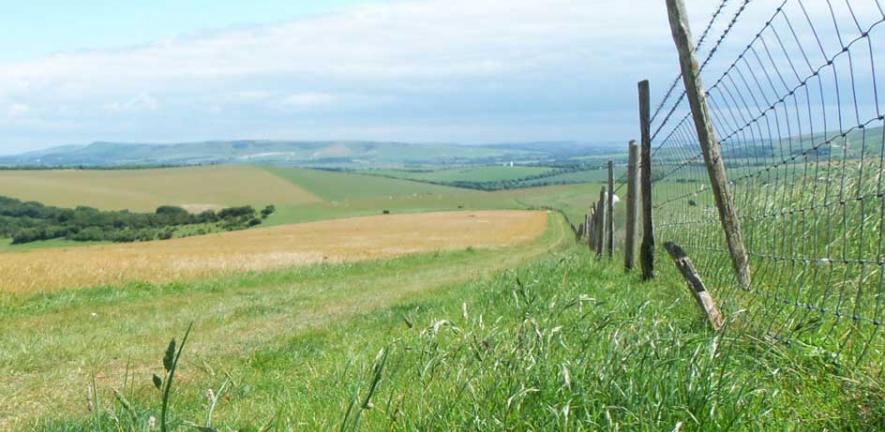
Cambridge academic Dr Robert Macfarlane’s new book – The Old Ways – is a remarkable excursion into the many-layered landscape of life and literature with countless stopping points along the route.
Cambridge academic Dr Robert Macfarlane’s new book – The Old Ways – is a remarkable excursion into the many-layered landscape of life and literature with countless stopping points along the route.
Paths relate, in several senses: they join place to place, and people to people. And they also keep and tell stories.
Dr Robert Macfarlane
Few paths go straight for long. Look at the public rights of way marked on an Ordnance Survey map and you’ll notice all manner of kinks and dog-legs in the green dotted lines. It’s only when you walk those same paths that the wiggles on the map make perfect sense: they avoid the boggy bits, skirt the deep woods, and cross the stream at the shallowest point where the stepping stones stand bold of the dancing water. The oldest paths were made to get from A to B, connecting places for living, working, meeting and worshipping. The feet that made them had a sense of purpose that took the smoothest, safest way, following the contours of the landscape with an elegant economy.
The Old Ways: A Journey on Foot (Hamish Hamilton, 2012) by Cambridge academic Dr Robert Macfarlane is a foot-path on an epic scale: a long-distance walking trail through Britain and beyond, taking the reader on a journey that dips not just into history, art and literature but also into geology, zoology and politics. It’s a voyage by land and sea with many diversions: the habits of the limpet and its unwavering homing instinct, the exquisite book-boxes made by Spanish artist Miguel Angel Blanco to record his walks, the barely-perceptible paths marked out by the crofter Manus across the moors on the Isle of Lewis.
The thread connecting this labyrinth of people, places and ideas is Macfarlane himself who takes us on a series of walks, and sea voyages, usually in the company of friends but sometimes on his own. There are surprises along the route (the freshly made chalk-on-flint drawings he finds at Cuckmere Haven on the Sussex coast); there is hardship (the tormenting midges of the Scottish summer, the biting cold of high Tibet); there are unexpected encounters (a man who has sold his house and taken to the road, his water in old Coca-Cola bottles lashed to his pack).
“Paths relate, in several senses: they join place to place, and people to people. And they also keep and tell stories,” says Macfarlane. “I set out to write a book that was path-like – full of meetings, findings and tellings.”
Macfarlane’s love for walking stems from childhood expeditions with his parents and grandparents in Scotland and the north of England. These family outings imprinted the textures, smells and sounds of the landscape into his being. One of the walks he describes is the long trek he makes over the Cairngorm mountains of Scotland to his grandfather’s funeral in the village of Tomintoul, where the minister concludes the service by saying: “What will survive of us is love.” As his grandfather had aged, his strong stride had become a shuffle and then a dodder. In parallel, Macfarlane’s two young children have found their legs, progressing from doodle to shuffle to stride.
A fascination with circularity, with the nature of things and the resonance between them, and with the inside-outness and the balance of opposites, is one of Macfarlane’s strongest themes. “Wherever I travelled, I met people for whom walking was a vital means of making sense of themselves,” he says.
In his earlier books, Mountains of the Mind and Wild Places, Macfarlane lays the foundations for an individual blend of travel and nature writing, at once personal and universal. In The Old Ways he gets even deeper into the materiality of the landscape, a process of gathering and treasuring that’s urgent in its intensity. His need to walk up mountains – to gain the high ground, to survey the spread of the world, to devour the landscape with all his senses – he describes at one point as almost unseemly. It’s this hunger for physical and spiritual experience that forges his connectedness not just with the natural world but with the writers and artists, past and present, whose work engages with earth, water, stone, sky and sea.
Walking and literature are old companions. Many of our best known poets and novelists were also walkers – among them William Wordsworth and Virginia Woolf. For some, walking was a way out of depression, a quest to shake off a cloud and find a new clarity. The poet Edward Thomas (1878-1917) is the inspiration for Macfarlane’s walks along some of the long distance paths of southern Britain – the Icknield Way (reputed by some to be the ‘oldest path’), the Ridgeway and South Downs Way. Thomas’s dark moods sent him off on long forays, often in poor weather, letting the rain wash away all but his ability to put one foot in front of the other.
The Scottish novelist and poet Nan Shepherd (1893-1981) is Macfarlane’s muse for journeys into the Cairngorms in the north-east of Scotland. She advocates walking barefoot and speaks of finding her way into, rather than up, the mountains. “I’ve long been fascinated by the relationship between walking and writing; the footprint as our first letter, the path as our first sentence, the journey as the original story,” says Macfarlane.
There’s humour too. Macfarlane saves his stories from over-earnestness by poking gentle fun at himself. He’s a novice sailor and fearful of setting out to sea from Stornoway in a small sailing boat; he’s horribly ill with altitude sickness on Minya Konka in Tibet; back in England he resists bragging about how many miles he has walked (but mentions enviously that the artist Richard Long once walked 33 miles per day for 33 days). His prose is interspersed with bursts of conversation that delight in their unmasking of differences. On the Isle of Harris he is talking to his friend, Steve Dilworth, a sculptor who gathers, takes apart and reconfigures dead animals. A lapwing tumbles overhead. “Lapwings have got those lovely spoon-shaped wings,” says Macfarlane. “They’re one of my favourite birds.” “Not much flesh on them,” replies Dilworth.
This is a book about the elements – a celebration of the stuff of land and sea – and our relationship with them. Sand and silt, peat and water, chalk and gneiss, granite and limestone, snow and ice. It’s about feeling and being, not just watching and seeing – an antidote to a life lived online and on screen. Though rejoicing in the sheer beauty of the shifts in landscape, sky and water, Macfarlane resists framing the natural world through nostalgia. Rather, he is true to his subject, putting his finger on the essence of where he is. Walking in Palestine with his friend Raja Shehadeh, he describes not just the terraces of lemon and pomegranate trees but also stepping round the corpses of two dogs, their pelts thick with a miniature world of mould, and the slew of discarded nappies flung from the balconies of the slums of the village of Ras Karkar, where plastic drinks bottles are embedded in the walls to save on concrete.
“It was clear to me from early on that I wanted to write about the present-tenseness of landscape: both its immediacy and the ways in which contemporary existence and politics press hard upon it,” says Macfarlane.
The book is generous in its sweep and scope as it unravels our most primitive – and atavistic - feelings about the land that sustains us. In a chapter titled Roots Macfarlane quotes Nan Shepherd who wrote in 1945: “As I watch [the world] it arches its back, and each layer of landscape bristles.”
Macfarlane, whose interest lies in words and their own journeys, develops this idea still further: “I prefer to think of the word [landscape] as a noun containing a hidden verb: landscape scapes, it is dynamic and commotion causing, it sculpts and shapes us not only over the courses of our lives but also incident by incident. I prefer to take ‘landscape’ as a collective term for the temperature and pressure of the air, the fall of light and its rebounds, the textures and surfaces of rock, soil and building, the sounds (cricket screech, bird cry, wind through trees), the scents (pine resin, hot stone, crushed thyme) and the uncountable other transitory phenomena and atmospheres that together comprise the bristling presence of a particular place at a particular moment.”
Robert Macfarlane is a Senior Lecturer in the Faculty of English and a Fellow of Emmanuel College. The Old Ways is published by Hamish Hamilton, 2012. His previous books are Mountains of the Mind: A History of a Fascination and The Wild Places.
This work is licensed under a Creative Commons Licence. If you use this content on your site please link back to this page.





